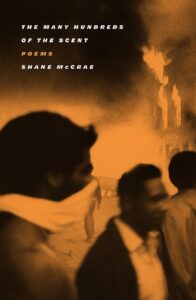
Shane McCrae on the Music of the Poetic Line
"Good poets take advantage of opportunities to make meter mean."
This first appeared in Lit Hub’s Craft of Writing newsletter—sign up here.
Initially, I had thought I would call this essay “On Small Turns.” After all, the thing I want to talk about looks small, at least. Then, I thought I might call it “On Meter and Small Turns,” since what I really wanted to talk about was meter. But I finally realized I wouldn’t want anybody to think the subject of this essay is small, comma though it is.
For one thing, it isn’t a particular comma — though the comma I was thinking about when I conceived this essay is a particular comma from a line of poetry by one of my students — and not being a particular comma it has the largeness of the idea of commas, perhaps the most capacious punctuation mark in English usage. When I say it isn’t a particular comma, I mean that, rather than a particular comma in a particular sentence, it is the comma used in a particular way, as in the comma in the line by my student, SA Wilson, that got me thinking. Here’s the line, preceded by 4/9 of the previous line (4/9 because, while both lines are in iambic tetrameter—four iambic feet per line—the first line has an extra-syllable ending, more commonly known as a feminine ending, and so were the whole line quoted it would have nine, rather than eight, syllables):
…Colors soften
to gray, yellow-gray blue—the moon
Why is that comma so important? Well, it is an occasion for thinking music.
As I mentioned, the lines are in iambic pentameter, which can be represented in the following way, the x’s indicating unstressed syllables, the virgules indicating stressed syllables, and the vertical lines indicating the boundaries between iambs: x / │ x / │ x / │ x /. Immediately, you will notice that if you were to scan the line with the comma, it wouldn’t look like that. Instead, it looks like this:
x / │ / x │ x / │ x /
to gray, yellow-gray blue—the moon
(With regard to the third foot, the iamb “gray blue,” it’s important to keep in mind that the speech stress of a phrase helps to determine which syllable in a foot carries the most stress, but also that when you are determining which syllable carries the most stress, you must only consider whether one syllable, compared to the other syllable in the foot—or syllables if it is a metrical foot that is made of more than two syllables, like an anapest or an amphibrach—carries more or less stress.) As you can see, the second foot in the line isn’t an iamb at all—it’s a trochee. What you’re looking at is a medial trochaic inversion—“medial” because it’s happening in the middle of a line rather than at the beginning. But what you’re looking at is also the sound of a mind working, that music.
Meter can be used in a meaningless way, to mark time. And often that’s a perfectly fine thing to do. But good poets take advantage of opportunities to make meter mean. In the quoted line, Wilson uses the comma to create space between the first foot and the second foot, and in that space turns the music around briefly, so that the reader hears the speaker of the poem adjusting their description of the progress of colors softening. Initially, the speaker leaps to the end of the process—“colors soften / to gray”—but immediately the speaker realizes they haven’t been true to the experience of the process, they haven’t communicated it, and so they adjust their thinking, they turn their mind around with the turning music of the line, and say no, before the final gray there was “yellow-gray blue.” That turn, as is the case with the comma that eased it, isn’t a metrical quirk, it’s a poetics. With that trochee the poet affirms their commitment to honest description—and/or the representation of honest description—not just of the thing seen but of seeing itself, of the dance of the mind with the senses. That trochee is both the music and the dance. That comma is the earth upon which the poet stands and sings.
______________________________________________

The Many Hundreds of the Scent by Shane McCrae is available now via Farrar, Straus and Giroux.
Shane McCrae
Shane McCrae is the author of five previous books of poetry: In the Language of My Captor, which was a finalist for the National Book Award, the Los Angeles Times Book Prize, and the William Carlos Williams Award; The Animal Too Big to Kill, winner of the 2014 Lexi Rudnitsky / Editor’s Choice Award; Forgiveness Forgiveness; Blood; and Mule. He is the recipient of a Whiting Writers’ Award and a National Endowment for the Arts Fellowship. He teaches at Columbia University and lives in New York City.



















